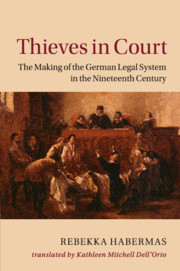Book contents
- Frontmatter
- Dedication
- Contents
- Acknowledgments
- Introduction: Questions Regarding Thieves, Reformers, Jurists, and Others
- PART I WHAT IS THEFT: QUESTIONS REGARDING THIEVES AND JURISTS – QUESTIONS REGARDING HONOR AND PROPERTY
- PART II HOW LAW IS MADE: EVIDENCE PRODUCTION
- PART III IN THE COURTROOM, OR WHAT IS LAW?
- 7 Reforms for More Legal Equality, Justice, and Public Openness?
- 8 The Meaninglessness of Jury Courts for Justice
- 9 Legitimation through Procedure
- 10 Irritations, Dissonances, and Various Other Matters: More Than Just Theater
- Conclusion: The Making of the Modern Legal System – Thieves and Property
- Relevant Laws
- Bibliography
- Index
9 - Legitimation through Procedure
from PART III - IN THE COURTROOM, OR WHAT IS LAW?
Published online by Cambridge University Press: 18 November 2016
- Frontmatter
- Dedication
- Contents
- Acknowledgments
- Introduction: Questions Regarding Thieves, Reformers, Jurists, and Others
- PART I WHAT IS THEFT: QUESTIONS REGARDING THIEVES AND JURISTS – QUESTIONS REGARDING HONOR AND PROPERTY
- PART II HOW LAW IS MADE: EVIDENCE PRODUCTION
- PART III IN THE COURTROOM, OR WHAT IS LAW?
- 7 Reforms for More Legal Equality, Justice, and Public Openness?
- 8 The Meaninglessness of Jury Courts for Justice
- 9 Legitimation through Procedure
- 10 Irritations, Dissonances, and Various Other Matters: More Than Just Theater
- Conclusion: The Making of the Modern Legal System – Thieves and Property
- Relevant Laws
- Bibliography
- Index
Summary
THE COURTROOM AS THE PLACE OF TRUTH: THE ROLE OF THE PUBLIC
How was the illusion of a self-contained sphere of legal action produced? First, a special room was chosen, where, second, special rules of behavior applied, which, third, the public scrutinized. That means that even the relatively inexpensive public staging of trials at the small high courts required separate, specially equipped rooms, as also familiar from churches, coronation rooms, and council chambers. These unique rooms emphasized the special nature of the activities that occurred there, a character that transcended the everyday, and detachment from all other, far too mundane spheres. Framing was built, indicating that self-contained events were involved. In Electoral Hesse, as in most of the federal states outside the Rhineland, rooms of this sort were not created until the last third of the century. In Marburg, too, an entirely distinct, monumental style of court architecture developed, conspicuously signaling to everyone that the court was a self-contained sphere. A separate court building was opened for occupancy there in 1871, and after that “cathedrals of law,” in many respects “state buildings of the castle variety,” were erected in other parts of Hesse. Only with the newly constructed court buildings, which represented their own form of architectural dominance, was the framework gradually perfected. Then came courtrooms characterized by barriers between the public and the court, elevation of the judge's bench, and placement of the judge's bench and the accused opposite each other, an arrangement in itself intended to make the importance of the public visible and tangible to all.
At mid-century, there could be no question of such spacious facilities or the generally dark paneling of the courtrooms, which were meant to convey dignity, solemnity, and a character beyond the mundane, and which also made clear that the rooms were not private but official. Without these architectural means of shaping space and dominance, without dedicated buildings, the framing of the court sessions must have still been relatively incomplete. However, in Marburg, at least, the topography of the place even before the construction of a dedicated building signaled that the court holding public sessions was to be viewed as a special location. In the beginning, the high court was housed in the Marburg landgraviate chancery – in a Renaissance building below the castle.
- Type
- Chapter
- Information
- Thieves in CourtThe Making of the German Legal System in the Nineteenth Century, pp. 209 - 243Publisher: Cambridge University PressPrint publication year: 2016



